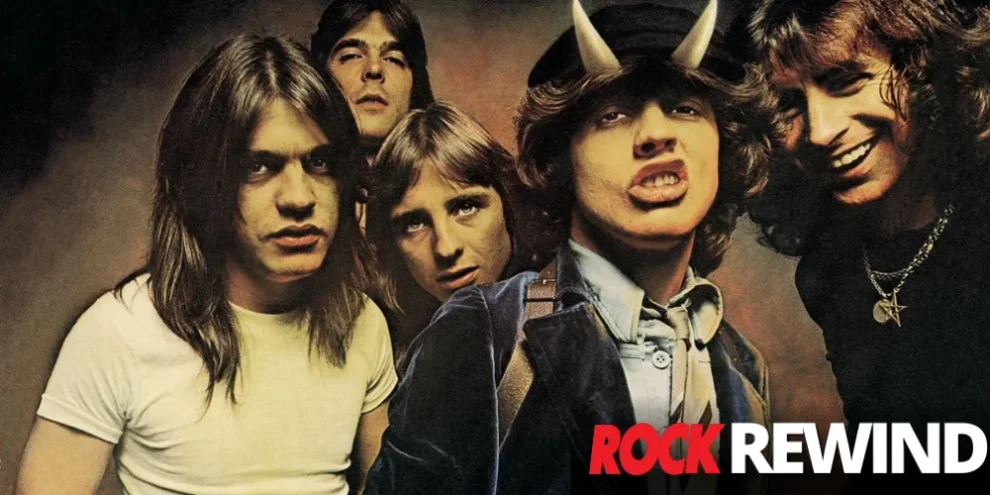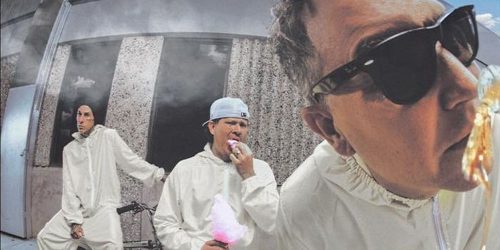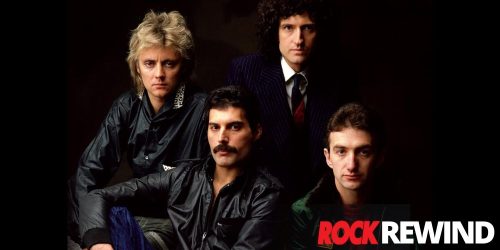Rock Rewind: The Full History Of AC/DC From High Voltage To Power Up

With classics like “Highway to Hell”, “Thunderstruck” and “Back in Black”, it’s unlikely you’ll meet a rock fan who doesn’t know the name AC/DC.
The Australian rock group was started by two Scottish-born brothers in Sydney. Malcolm Young played rhythm guitar. His younger brother Angus Young, who’s known for his schoolboy uniform, plays lead guitar.
Over the years AC/DC has sold over 200 million records. They became the 9th highest-selling artist in the US and the 15th best worldwide.
Jump To:
AC/DC Band Members | Discography
How AC/DC Got Their Name
AC/DC is an abbreviation for “alternating current/direct current”. In the world of electricity, this means that a device is compatible with both types of current. For the Young brother’s it represented their powerful performances and high energy.
Malcolm and Angus' sister discovered the term while working at her sewing machine. Malcolm shared the story in a short documentary.
“Her sewing machine had AC/DC on the back of it. We were tossing around names for weeks and she just said it one night. And everyone went, ‘that's good’.”
While Australians call them Acca Dacca, the correct pronunciation is one letter at a time.
AC/DC Band Members
From their inception in 1973 until the release of their first album in 1975, AC/DC went through a few band mates. This included Larry Van Kriedt, Dave Evans, and Colin Burgess.
Originally, the band had a glam rock image. This was mostly attributed to Dave Evans’ look and sound on lead vocals. But when AC/DC decided to pursue a harder blues-rock sound, Bon Scott replaced Evans.
The lineup following the 1975 release of High Voltage was:
Vocals: Bon Scott
Lead Guitar: Angus Young
Rhythm Guitar: Malcolm Young
Drums: Phil Rudd
Bass: Mark Evans
Cliff Williams Joins The Band
In 1977, AC/DC fired bassist Mark Evans. Michael Browning, who was their manager at the time, talked about the incident in the book AC/DC: Maximum Rock & Roll …
"I got a call one day from Malcolm and Angus. We were in London, I went to their apartment and they told me they wanted to get rid of Mark. Him and Angus didn't see eye to eye. They used to have a sort of tit-for-tat thing going, but nothing that I would have ever thought was going to be gig-threatening."
In an interview with Let There Be Talk, Evans explained, “I had a bit of a run-in with Angus. I think I got up in his nose about something maybe, but maybe if I had been a bit more mature and maybe not drank so much, I would be able to handle the situation better.”
The band fired Evans for musical differences and personal issues with Angus Young. Cliff Williams replaced him on Bass.
Bon Scott Passes Away And Brian Johnson Joins AC/DC
Bon Scott was a friend of Malcolm and Angus’ brother George. In 1980, 7 months after the release of Highway to Hell, Scott died of acute alcohol poisoning.
“Bon was a gypsy, a vagabond, a buccaneer, a bad boy and a rock’n’roll outlaw. He was truly a street poet, documenting in lyric and performance all that he thought, felt and cared about life. He was the only other singer I ever invited to sing with the Tatts – whenever he felt like it.”
– Angry Anderson, Singer for Rose Tattoo
Scott died in a Renault 5 parked outside 67 Overhill Road, in East Dulwich, South London. His friend Alistair Kinnear had driven him home after a night of binge drinking. He had passed out on the ride over. Kinnear couldn’t move him so he left him in the car to sleep it off. Scott was declared dead later that day. A silver plate hangs at the address with hastily written messages to Scott.
Scott’s death almost ended the band. “We wanted to continue the band but we just didn’t have the will to at the time,” Malcolm shared.
Eventually they decided to continue on with Brian Johnson of Geordie on vocals.
Angus once said, “I remember the first time I had ever heard Brian's name was from Bon. Bon had mentioned that he had been in England once touring with a band and he had mentioned that Brian had been in a band called Geordie and Bon had said 'Brian Johnson, he was a great rock and roll singer in the style of Little Richard.' And that was Bon's big idol, Little Richard. I think when he saw Brian at that time, to Bon it was 'Well he's a guy that knows what rock and roll is all about.' He mentioned that to us in Australia. I suppose when we decided to continue, Brian was the first name that Malcolm and myself came up with, so we said we should see if we can find him.”
View this post on Instagram
Johnson’s first album with the band was Back in Black, which they dedicated to Bon Scott. It was one of the best selling albums of all time.
Phil Rudd Leaves For The First Time
In 1983, Phil Rudd left the band after recording his drumming for Flick of the Switch. There were rumors about the reasons for his departure. This included personal issues with Malcolm, as well as drug and alcohol abuse.
Simon Wright replaced Rudd as drummer. He was with the band until 1989.
View this post on Instagram
Slade Takes Over For Wright, Then Rudd Returns
Wright left the band in 1989 so he could have more creative freedom. In an interview with VW Music, Wright explained, “I just wanted to play more…It’s a kind of a regimented style of playing with them. I found myself playing more when I was at home.”
Chris Slade replaced Wright later that year. His first and only album with AC/DC was The Razors Edge.
View this post on Instagram
In 1994, Slade left the group when the band reconnected with Phil Rudd.
In an interview, Slade recalled, “I'd been doing demos with the guys in London for two months. Mal called me and said it was nothing to do with me and was nothing I was doing or not doing, but they wanted to give Phil a try. I said, 'That's me out then, I'm gone.’ Mal said, 'No, no, no we want to keep you on, we don't even know if Phil can play,' and I told him that was his problem now. If it ain't broke, don't fix it. I resigned the next day.”
Things Stabilize For a While
For 20 years, the bands lineup remained the same:
Vocals: Brian Johnson
Lead Guitar: Angus Young
Rhythm Guitar: Malcolm Young
Drums: Phil Rudd
Bass: Cliff Williams
View this post on Instagram
Malcolm Young Retires and Phil Rudd Leaves For A Second Time
In 2014, Malcolm Young retired because of early-onset dementia. His nephew, Stevie Young, took over for him on rhythm guitar and debuted on Rock or Bust.
Chris Slade returned to the band to replace Rudd during the Rock or Bust tour. Rudd had been sentenced to 8 months of home detention for threatening to kill and drug possession.
View this post on Instagram
In 2016 Rudd shared, "I have had to get help on my issues. I've never felt better in my life. Physically, mentally, I am in the best shape I have ever been." He didn’t return to the band until later.
Johnson And Williams Retire
Part way through the Rock or Bust tour in 2016, Johnson retired due to worsening hearing loss. In an interview with Howard Stern, Johnson explained, "I've got hearing loss in me left ear. I didn't get it from music. I got it from sitting in a race car too long without ear plugs. I heard my ear drum burst, because I forgot to put me plugs in under my helmet. That's how it happened. Music had nothing to do with it."
Axl Rose joined AC/DC to finish up the remaining shows.
View this post on Instagram
At the end of the tour, Cliff Williams also retired. In an interview with Gulfshore Life, Williams explains, “It's been what I've known for the past 40 years, but after this tour I'm backing off of touring and recording. Losing Malcolm, the thing with Phil and now with Brian, it's a changed animal. I feel in my gut it's the right thing.”
Rock Or Bust Lineup Is Back
AC/DC experienced a hiatus until 2020 when the original Rock or Bust lineup reunited for Power Up.
Vocals: Brian Johnson
Lead Guitar: Angus Young
Rhythm Guitar: Stevie Young
Drums: Phil Rudd
Bass: Cliff Williams
View this post on Instagram
AC/DC Discography
Since 1975, AC/DC has put out:
3 live albums - If You Want Blood You’ve Got It (1978), AC/DC Live (1992) and Live At River Plate (2012)
2 box set albums - Bonfire (1997) and Backtracks (2009)
2 soundtracks - Who Made Who (1986 for Maximum Overdrive) and Iron Man 2 (2010)
11 video albums - AC/DC:Let There Be Rock (1980), Fly On The Wall (1985), Who Made Who (1986), AC/DC (1989), Clipped (1991), Live At Donington (1992), No Bull (1996), Stiff Upper Lip Live (2001), Family Jewels (2005), Plug Me In (2007), and Live At River Plate (2011)
They’ve also released 17 studio albums …
1. High Voltage (1975)
High Voltage was the band’s first studio album, which was exclusively released in Australia. Phil Rudd had not yet joined as drummer.
An album of the same name was later released internationally in 1976. It was a compilation of AC/DC’s first two albums. The album wasn’t received well. In a 1976 review, Rolling Stone said, “Hard Rock has unquestionably hit its all-time low."
2. T.N.T. (1975)
T.N.T. released exclusively in Australia and New Zealand. It’s said to be the first album where AC/DC fully embraced their trademark sound.
In the book AC/DC: Maximum Rock & Roll, their producer Harry Vanda said:
"I suppose there might have been one or two tracks on the first album, a few things that they were experimenting with, which probably later on they wouldn't have done anymore. So I suppose you could say that T.N.T was the one that really pulled the identity; like, this is AC/DC, there's no doubt about it, that's who it's going to be and that's how it's going to stay."
3. Dirty Deeds Done Dirt Cheap (1976)
Dirty Deeds was the first album released in Australia and Europe in the same year. Track listings varied internationally and the album was not released in the US until 1981.
Once released in the US, the Dirty Deeds made it to No. 3 on the Billboard 200 chart. It’s also AC/DC’s third highest selling album in the US.
Humphrie Bogart’s movies were the inspiration behind the album, while the name “Dirty Deeds Done Dirt Cheap” pays tribute to a cartoon that Angus watched when he was a kid called Beany and Cecil.
According to the band, Stephen King sang along to “Ain’t No Fun” from the Dirty Deeds album to prove how big of a fan he was. King sang the whole song from beginning to end because he wanted AC/DC to create a soundtrack for Maximum Override. AC/DC performed all the songs in the film but two and recorded them on a soundtrack called Who Made Who.
4. Let There Be Rock (1977)
Let There Be Rock was the last album with Mark Evans on bass. While it didn’t top any charts, it was a big album for the band.
Before recording, the band got some unwelcome news …
According to their manager Michael Browning, “In the middle of the tour, I get a phone call saying Atlantic Records in America didn‘t like the Dirty Deeds album. That, in fact, they were going to drop the group from the label. And that’s when things got really bad.”
The American head didn’t see how AC/DC’s sound would fit in with the soft rock music that was growing in popularity. AC/DC didn’t compromise and put out an album that was fueled by their “we’ll show them” attitudes.
“There was always a siege mentality about that band,” says Mark Evans. “But once we all found out that Atlantic had knocked us back the attitude was: ‘F*ck them! Who the f*ck do they think they are?’ So from that point onwards it was: ‘F*ck, we’ll show them!’ We were seriously f*cking pissed off about it. It didn’t need to be discussed. We were going to go in and make that album and shove it up their arse.”
5. Powerage (1978)
Powerage was the first album with Cliff Williams on bass. For many, it was also a turning point for Bon Scott’s lyrics.
"'Gimme a Bullet' was perhaps Bon's most accomplished piece of writing to date, in which his penchant for hardcase metaphors finds even more genuine pathos and humour than it had before,” – Clinton Walker, author of Highway to Hell.
6. Highway to Hell (1979)
Highway to Hell was AC/DC’s first big album and the last featuring Bon Scott. It was also the first album produced by someone other than Harry Vanda and George Young, who was Malcolm and Angus’ older brother.
The reason for the production change was pressure from the American label. Up to this point, AC/DC has little radio presence in the US. The label felt that the band needed a producer that could help them achieve a radio-friendly sound.
Angus, Malcolm and the other band members were not happy with this.
“Being told what to do was bad enough but what really pissed off Malcolm and Angus was they felt that George was being treated disrespectfully by Atlantic, like an amateur with no great track record when it came to production ... Malcolm seemed less pleased with the situation and went so far as to tell Radio 2JJ in Sydney that the band had been virtually "forced" to go with an outside producer. Losing Harry was one thing. Losing George was almost literally like losing a sixth member of the band, and much more.”
– AC/DC: Maximum Rock & Roll by Murray Engleheart with Arnaud Durieux
Ultimately, they ended up working with Robert John “Mutt” Lange, a producer they approached for help.
In one article, Angus talks about Lange, “He was meticulous about sound, getting right guitars and drums. He would zero in—and he was good too on the vocal side. Even Bon was impressed with how he could get his voice to sound."
Highway to Hell was their first album to break into the top 100 in the US at No. 17.
7. Back In Black (1980)
Dedicated to Bon Scott, this was the first album with Brian Johnson as lead singer. While Scott has already written some lyrics for the album, the band rewrote all the songs. They didn’t want to profit from his passing.
Johnson admits he felt pressure during the album recording. Especially from Lange, who wanted perfect vocals. Johnson recalls:
“It was like, 'Again, Brian, again – hold on, you sang that note too long so there's no room for a breath'. He wouldn't let anything go past him. He had this thing where he didn't want people to listen to the album down the road and say there's no way someone could sing that, they've dropped that in, even the breaths had to be in the right place. And you cannot knock a man for that, but he drove me nuts. I'd be sitting there going, 'Arrggghh!'.”
But the work was worth it …
Back in Black became the 2nd best selling album of all time with over 50 million copies sold. The album was No. 1 in the UK, No. 4 in the US, and spent over two years on the Billboard 200 chart.
In a 1980 review, the Rolling Stone said, Back in Black was "the apex of heavy-metal art: the first LP since Led Zeppelin II that captures all the blood, sweat and arrogance of the genre.”
8. For Those About To Rock We Salute You (1981)
For Those About to Rock was the last album made with Lange as producer. It was also the first album to reach No. 1 on the US Billboard 200 chart. Even still, it wasn’t nearly as well received as Back in Black. In the US it sold 4 million copies.
The title song was one of the biggest hits on the album. British poet and novelist, Robert Graves, was the inspiration behind the song. Angus explains:
“The funny thing is, when we got to the chorus, we were going, ‘Okay, what are we going to sing on this?’ And for me, I just thought, well, sometimes I go back [to] something I've read somewhere, and there was the writer Robert Graves, I believe his name was, I think he had a book out or a story he had put in one of the papers, because he did a lot of history stuff. And I had read it and it was, ‘For those about to die,’ and he went into a day in the Coliseum or somewhere in Rome at the time and the thing that the gladiators did. And I thought, ‘That might fit…”
The iconic canons associated with the title track and album had a different inspiration …
On one of the days AC/DC was working on the song, Princess Diana’s wedding was on TV. The cannons went off in celebration and the band really liked it. They added it to the song, used a canon for the album cover and began featuring them in their shows.
Angus Young shared in an interview, “I just wanted something strong.. And what’s more masculine than a cannon, y’know?”
9. Flick Of The Switch (1983)
While Angus has conceded that Lange did a great job with Those About to Rock, tensions were high during its recording. He shared that the band was “bored shitless” while Lange perfected everything.
Their tour manager at the time explained that Malcolm had decided he was done with Lange:
“It really soured when they started to look at the figures Mutt was being paid. They felt that they didn’t need him: ‘We write the songs and now we know what to do, we’ve done a couple of albums with him, game’s up, you know, we don’t need him any more’.”
AC/DC dropped Lange and decided to produce Flick of the Switch themselves. They wanted to get back to the rawness of their original sound.
"We wanted this one as raw as possible. We wanted a natural, but big, sound for the guitars. We didn't want echoes and reverb going everywhere and noise eliminators and noise extractors."
– Angus Young
But part way through recording, things got bad with Rudd and they dropped him part way through recording.
Tony Platt, the band’s engineer, recalled, “It wasn't a happiest of albums. There were all sorts of tensions within the band. They were all pretty knackered by that point. It was the album that copped the backlash, really."
When they released the album, it marked the start of the band's commercial decline.
Rolling Stone’s opinion was that “the Youngs' retooling of old riffs for new hits also teeters on self-plagiarism at times.”
Even still, AC/DC remained one of the biggest hard rock bands worldwide.
10. Fly On The Wall (1985)
Fly on the Wall was the first album ever without Phil Rudd. Simon Wright replaced him on drums.
Like Flick of the Switch, the album was self-produced. But this time only Malcolm and Angus Young produced … not the whole band. And, also like their last album, the reception was poor.
"You'd never guess how sexist and politically incorrect all this is if you didn't read the lyric sheet, because you sure can't make out a single word coming out of the dentist's-drill glottis of Brian Johnson (except maybe the song titles, which tend to be repeated like mantras). Angus Young is also in great form, playing the dumbest, most irresistibly repetitive chords in the lexicon.”
– Rolling Stone review of Fly on the Wall
Bad publicity coverage related to Richard Ramirez's arrest made things even worse. Not only had the serial killer been dawning AC/DC clothing during his arrest … he also told police that their song “Night Prowler” had driven him to murder. This fueled accusations that AC/DC were devil worshipers.
11. Blow Up Your Video (1988)
For Blow Up Your Video, AC/DC returned to producers Harry Vanda and George Young. It was the best AC/DC album since For Those About to Rock We Salute You. The album reached No. 2 on UK charts and No. 12 in the US. It also sold more copies than the last two albums combined.
Angus has shared that it was during the recording of Blow Up Your Video that he realized his brother was an alcoholic. "I saw the signs. Malcolm had a problem. I said if he didn't get his act together, I was out of there. I don't recall it having any effect."
Remembering Bon Scott’s own struggles, Malcolm began attending AA meetings. "My drinking overtook my whole thing. I felt like Dr. Jekyll and Mr. Hyde. I had a talk with Angus... I was letting people down... I wasn't brain-dead, but I was just physically and mentally screwed by the alcohol," explained Malcolm.
He also took time off of the Blow Up Your Video tour. His nephew, Stevie Young, took his place at the live shows until he returned.
12. The Razors Edge (1990)
The Razors Edge was a major comeback for the band. Recorded in Vancouver with producer Bruce Fairbairn, the album reached No. 2 on the US Billboard 200 Charts and went platinum.
"Tight, highly strung and menacing ... entirely worthy of its status as the grand comeback of legendary rock 'n' roll runts"
– Martin Popoff, Canadian journalist
This is the only time Chris Slade was on an album, though he was with the band for 5 years. It was also the first album where the Young brother’s were solely responsible for lyrics. A practice that continued, as they moved forward.
The top performing song on the album was “Thunderstruck”, which reached No. 5 in the US.
In the liner notes of the 2003 re-release, Angus talks about writing the song:
"It started off from a little trick I had on guitar. I played it to Mal and he said 'Oh, I've got a good rhythm idea that will sit well in the back.' We built the song up from that. We fiddled about with it for a few months before everything fell into place. Lyrically, it was really just a case of finding a good title...We came up with this thunder thing and it seemed to have a good ring to it. AC/DC = Power. That's the basic idea."
RELATED: The film Varsity Blues paid $500,000 to feature "Thunderstruck" ...
13. Ballbreaker (1995)
Ballbreaker was the first album after Rudd’s return to drumming in 1994. It was the only studio album produced by Rick Rubin, though he had also produced their song “Big Gun”, from the movie Last Action Hero. The partnership didn’t last long due to clashes about the album’s direction.
“Hard as a Rock”, the first single on the album, made it to No. 1 on US Mainstream.
Even still, the reviews of the album varied. Some were less impressed, like Rolling Stone:
"Their longevity can be credited to two factors: nostalgia and the fact that AC/DC still view the world through the mind of a horny 15-year-old. God knows there's more than enough of them to go around."
Others, like AllMusic, found a few good words to say:
"Although 'Hard as a Rock' comes close, there aren't any songs as immediately memorable as any of their '70s classics, or even 'Moneytalks.' However, unlike any record since Back in Black, there are no bad songs on the album."
14. Stiff Upper Lip (2000)
Stiff Upper Lip was the last album that George produced for his brothers. The album reached No. 5 in Canada and No. 7 in the US. The title track also sat at No. 1 on the US Mainstream Rock charts for 4 weeks.
The album returned to AC/DC’s blues roots and was better received than their previous album.
15. Black Ice (2008)
8 years passed before AC/DC put out their next album. This was in part thanks to their new label - Sony Music Entertainment. Angus explained that Sony was releasing DVDs and remasters of past work. This gave the band time to wait until they really had something good.
This freedom worked out for them. Black Ice was the second highest selling album of 2008. It also went multi-platinum in 8 countries and charted No. 1 in 29 countries. The song “Rock ‘n’ Roll Train” made it to No. 1 on US Mainstream.
For Black Ice, AC/DC worked with Brendan O’Brien, a producer who had worked with other popular rock groups. He wanted to move away from blues and bring back the band’s earlier sound.
O’Brien also got Johnson to move away from screaming and bring in more crooning. Because of the demands of this singing style, Johnson only recorded vocals for an hour a day.
Critics appreciated the classic AC/DC sound and the album received many award nominations.
16. Rock Or Bust (2014)
Rock or Bust was the first album without Malcolm Young. His nephew, Stevie Young, who had taken his place during part of the Blow Up Your Video tour, took over rhythm guitar.
It was the shortest studio album ever released by the band but hit No. 1 in 12 countries.
During and after the supporting tour, there were many changes to the band’s lineup. Slade replaced Rudd on drums and Axl Rose stepped in for Johnson on vocals. Cliff Williams finished the tour, but retired right after.
17. Power Up (2020)
In 2018, rumors were flying about AC/DC recording a new album with the original Rock or Bust lineup. In 2020 the album was released.
Dedicated to Malcolm, Rock or Bust was the first album since his death in 2017. It reached No. 1 in 27 countries and won the iHeartRadio Rock Album of the Year award. The song “Shot in the Dark” made it to No. 1 on US Mainstream.
"Good times have always been a crucial part of the band, but there's a depth of feeling to the levity on Power Up, as if the band decided that the best way to pay respect to what they've lost is by focusing on what they still have. They don't dwell upon the past, they barrel forward with a set of turbocharged blues and high-octane rock that doesn't merely sound good, it feels nourishing."
– AllMusic
AC/DC has had many obstacles to overcome since their inception in the 1970s. But their perseverance paid off, making them one of the most influential rock bands in history. With over 200 million records sold worldwide, AC/DC has become the 15th best-selling artist worldwide.
And while AC/DC’s music has fallen under many genres … to band members and their fans, they’ll always be rock and roll.
"A rock and roll band, nothing more, nothing less."
Snag Our Newsletter
Hit that button like you’re pressing play on your favourite track. get exclusive content, stories, and news.







